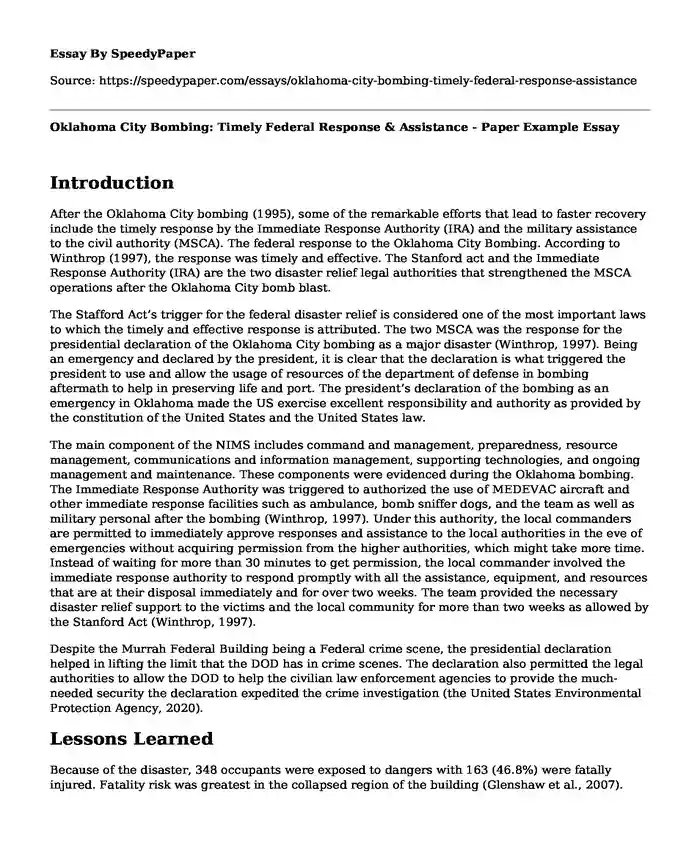
| Type of paper: | Essay |
| Categories: | Government Army |
| Pages: | 3 |
| Wordcount: | 736 words |
Introduction
After the Oklahoma City bombing (1995), some of the remarkable efforts that lead to faster recovery include the timely response by the Immediate Response Authority (IRA) and the military assistance to the civil authority (MSCA). The federal response to the Oklahoma City Bombing. According to Winthrop (1997), the response was timely and effective. The Stanford act and the Immediate Response Authority (IRA) are the two disaster relief legal authorities that strengthened the MSCA operations after the Oklahoma City bomb blast.
The Stafford Act’s trigger for the federal disaster relief is considered one of the most important laws to which the timely and effective response is attributed. The two MSCA was the response for the presidential declaration of the Oklahoma City bombing as a major disaster (Winthrop, 1997). Being an emergency and declared by the president, it is clear that the declaration is what triggered the president to use and allow the usage of resources of the department of defense in bombing aftermath to help in preserving life and port. The president’s declaration of the bombing as an emergency in Oklahoma made the US exercise excellent responsibility and authority as provided by the constitution of the United States and the United States law.
The main component of the NIMS includes command and management, preparedness, resource management, communications and information management, supporting technologies, and ongoing management and maintenance. These components were evidenced during the Oklahoma bombing. The Immediate Response Authority was triggered to authorized the use of MEDEVAC aircraft and other immediate response facilities such as ambulance, bomb sniffer dogs, and the team as well as military personal after the bombing (Winthrop, 1997). Under this authority, the local commanders are permitted to immediately approve responses and assistance to the local authorities in the eve of emergencies without acquiring permission from the higher authorities, which might take more time. Instead of waiting for more than 30 minutes to get permission, the local commander involved the immediate response authority to respond promptly with all the assistance, equipment, and resources that are at their disposal immediately and for over two weeks. The team provided the necessary disaster relief support to the victims and the local community for more than two weeks as allowed by the Stanford Act (Winthrop, 1997).
Despite the Murrah Federal Building being a Federal crime scene, the presidential declaration helped in lifting the limit that the DOD has in crime scenes. The declaration also permitted the legal authorities to allow the DOD to help the civilian law enforcement agencies to provide the much-needed security the declaration expedited the crime investigation (the United States Environmental Protection Agency, 2020).
Lessons Learned
Because of the disaster, 348 occupants were exposed to dangers with 163 (46.8%) were fatally injured. Fatality risk was greatest in the collapsed region of the building (Glenshaw et al., 2007). Those people over 40 years of age were most affected and they were at high risk of fatality (or 3.7, 95% ci 1.4–9.8). For the sake of fatality, the response team should have focused on protecting the vulnerable building occupants such as children and the elderly (Jensen & Youngs, 2014). Additionally, the response groups including law enforcement agencies, local authorities, the police, and the DOD should have established a single command center where all actions are coordinated (Glenshaw et al., 2007).
The response to the establishment of a single command center can be attributed to the development of the National Response Framework (NRF). The NRF establishes a single but most comprehensive approach to any form of domestic incident management. The response during the disaster was effective in informing the establishment of the NRF by acting as a framework that guided the prevention, preparation for, response to, as well as recovery from disasters and incidences.
References
Glenshaw, M., Enrick, J., Li, G., Sorock, G., Brown, S., & Mallonee, S. (2007). Preventing Fatalities in Building Bombings: What Can We Learn From the Oklahoma City Bombing?. Disaster Medicine and Public Health Preparedness, 1(1), 27-31. https://doi.org/10.1097/dmp.0b013e3180640cd7
Jensen, J., & Youngs, G. (2014). Explaining the implementation behavior of the National Incident Management System (NIMS). Disasters, 39(2), 362-388. https://doi.org/10.1111/disa.12103
The United States Environmental Protection Agency. (2020). National Response Framework (NRF) | US EPA. US EPA. Retrieved 15 August 2020, from https://www.epa.gov/emergency-response/national-response-framework-nrf.
Winthrop, J. (1997). Oklahoma City Bombing: Immediate Response Authority and Other Military Assistance to Civil Authority (MACA). Ncjrs.gov. Retrieved 15 August 2020, from http://www.ncjrs.gov/App/publications/abstract.aspx?ID=189854.
Cite this page
Oklahoma City Bombing: Timely Federal Response & Assistance - Paper Example. (2023, Nov 14). Retrieved from https://speedypaper.com/essays/oklahoma-city-bombing-timely-federal-response-assistance
Request Removal
If you are the original author of this essay and no longer wish to have it published on the SpeedyPaper website, please click below to request its removal:
- Essay Example on Imprisoned Elderly Males
- PTSD Research Paper Example
- Law Essay Example: The Case of Adnan
- Essay Sample on Interventions on Reducing HCV Prevalence in the Incarcerated Population
- Free Essay on Serving Veterans as a Mental Health Nurse
- Karl Marx and Capitalism, Free Essay for Everyone
- Assignment Example on Individual Responsibility and State Responsibility
Popular categories




